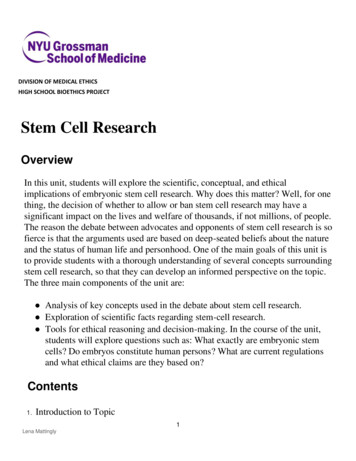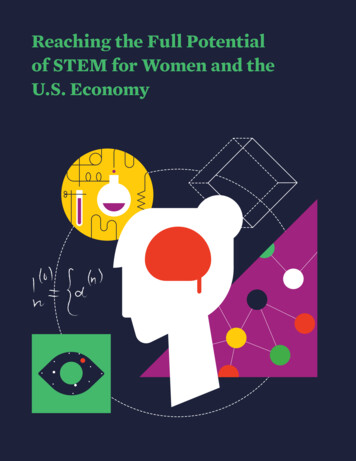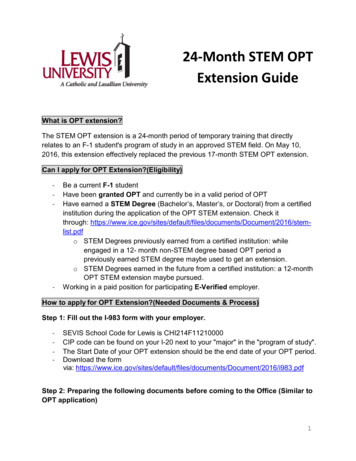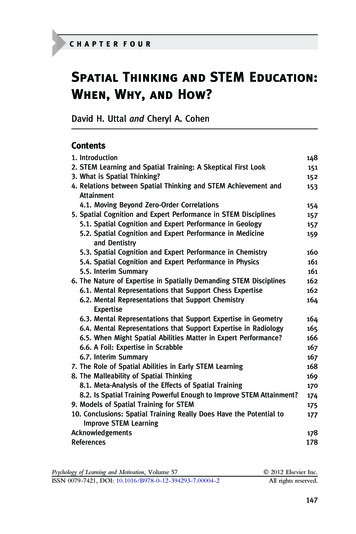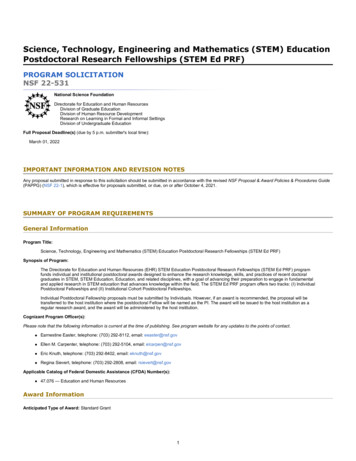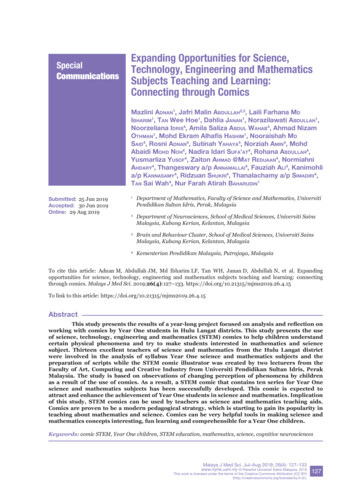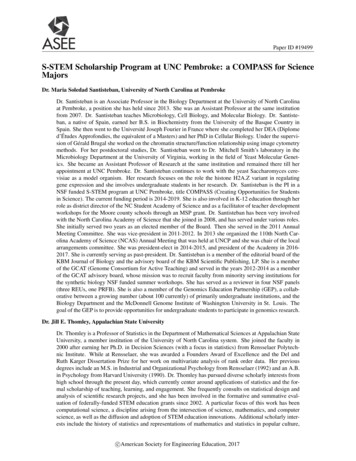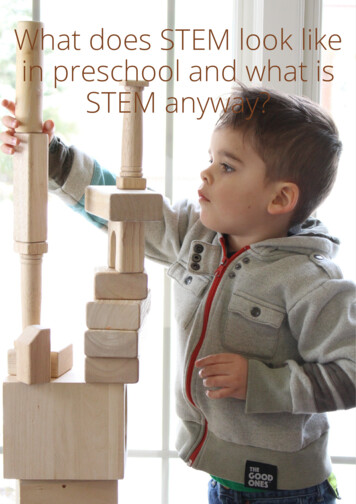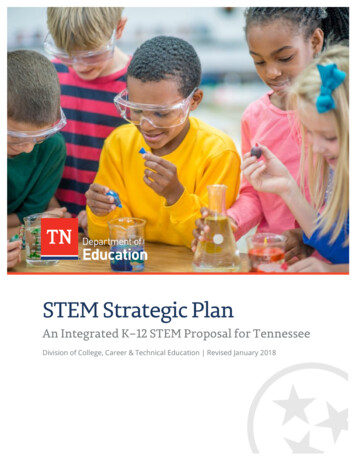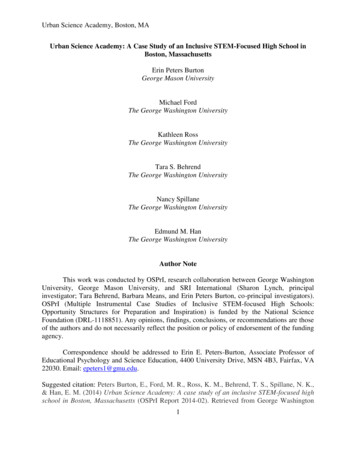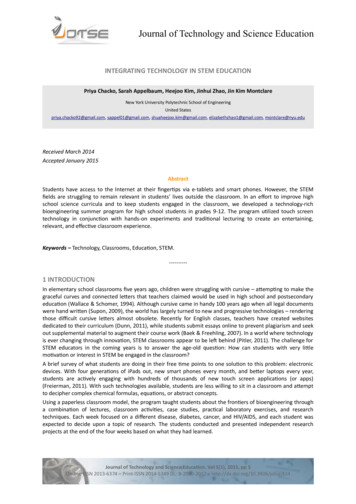
Transcription
Journal of Technology and Science EducationINTEGRATING TECHNOLOGY IN STEM EDUCATIONPriya Chacko, Sarah Appelbaum, Heejoo Kim, Jinhui Zhao, Jin Kim MontclareNew York University Polytechnic School of EngineeringUnited Statespriya.chacko92@gmail.com, sappel01@gmail.com, shuaheejoo.kim@gmail.com, elizabethzhao1@gmail.com, montclare@nyu.eduReceived March 2014Accepted January 2015AbstractStudents have access to the Internet at their fngertps via e-tablets and smart phones. However, the STEMfelds are struggling to remain relevant in students’ lives outside the classroom. In an efort to improve highschool science curricula and to keep students engaged in the classroom, we developed a technology-richbioengineering summer program for high school students in grades 9-12. The program utlized touch screentechnology in conjuncton with hands-on experiments and traditonal lecturing to create an entertaining,relevant, and efectve classroom experience.Keywords – Technology, Classrooms, Educaton, STEM.----------1 INTRODUCTIONIn elementary school classrooms fve years ago, children were struggling with cursive – atemptng to make thegraceful curves and connected leters that teachers claimed would be used in high school and postsecondaryeducaton (Wallace & Schomer, 1994). Although cursive came in handy 100 years ago when all legal documentswere hand writen (Supon, 2009), the world has largely turned to new and progressive technologies – renderingthose difcult cursive leters almost obsolete. Recently for English classes, teachers have created websitesdedicated to their curriculum (Dunn, 2011), while students submit essays online to prevent plagiarism and seekout supplemental material to augment their course work (Baek & Freehling, 2007). In a world where technologyis ever changing through innovaton, STEM classrooms appear to be lef behind (Pitler, 2011). The challenge forSTEM educators in the coming years is to answer the age-old queston: How can students with very litlemotvaton or interest in STEM be engaged in the classroom?A brief survey of what students are doing in their free tme points to one soluton to this problem: electronicdevices. With four generatons of iPads out, new smart phones every month, and beter laptops every year,students are actvely engaging with hundreds of thousands of new touch screen applicatons (or apps)(Freierman, 2011). With such technologies available, students are less willing to sit in a classroom and atemptto decipher complex chemical formulas, equatons, or abstract concepts.Using a paperless classroom model, the program taught students about the fronters of bioengineering througha combinaton of lectures, classroom actvites, case studies, practcal laboratory exercises, and researchtechniques. Each week focused on a diferent disease, diabetes, cancer, and HIV/AIDS, and each student wasexpected to decide upon a topic of research. The students conducted and presented independent researchprojects at the end of the four weeks based on what they had learned.Journal of Technology and Science Educaton. Vol 5(1), 2015, pp 5On-line ISSN 2013-6374 – Print-ISSN 2014-5349 DL: B-2000-2012 – htp://dx.doi.org/10.3926/jotse.124
Journal of Technology and Science Educaton – htp://dx.doi.org/10.3926/jotse.1242 OBJECTIVESThe overarching objectve of the research was to investgate how incorporatng “paperless” technology wouldbeneft educaton and increase an interest in the STEM felds. By incorporatng a curriculum that focusesgradually on students learning independently rather than relying on textbooks and lecture-based learningtraditonally utlized in STEM classrooms, students were to increase their understanding of topics covered aswell as create an independent research project to present at the end of four weeks.3 APPROACHFor the last two years, two groups of students in 9th through 12th grade from various New York City schoolspartcipated in a paperless summer science program in which technology was fully integrated into scienceeducaton. This program aimed to educate high school students about health related topics including diabetes,cancer and HIV/AIDS while encouraging them to conduct independent research. The four week program ranfrom July-August for a group of an average of 18 students (the number of students who partcipated in theprogram varied from year to year, but overall atendance never waivered from week to week). Each topic wasintroduced by a technical lecture. Once the students were given the background informaton, laboratoryexperiments were conducted in small groups. Aferwards, students and instructors discussed the results. Usingwhat they learned from the lecture and lab, students were then given classroom actvites to complete basedon the course curriculum (Table 1). For our curriculum, classroom actvity is defned as experiences involvingstudents manipulatng their knowledge by partcipatng in discussions, creatng presentatons, assessing casestudies, watching videos, and topic related games/actvites. At the end of every week, students were given anevaluaton of the module to determine whether or not they had increased their understanding in the STEMfeld covered and their interest level in pursuing a STEM feld as a career afer high school. In this way, themodules could be evaluated by data provided by students.MondayIntroducton toprogramLecture: Introducton toEpidemiologyLecture: Introducton toepidemiologyLecture: Introducton todiabetesMondayActvity: Immortal Lifeof Henrieta LacksreadingLecture: Biology ofcancerActvity: Causes ofcancerLecture: Guest SpeakerAcademic ResearcherWeek 1: DiabetesTuesdayWednesdayLecture: Biology ofLecture: How to makediabetesa scientfc posterActvity: Diabetestreasure huntLecture: Technologyand diabetesActvity: Diabetesbusiness case studyLecture: Do’s andActvity: Genetcs anddon’ts of makingdiabetesscience-relatedpresentatonsWeek 2: CancerTuesdayWednesdayLecture:Lecture: Types ofComputatonalcancer treatmentsmodelingActvity: Guest LectureLab: DNA RestrictonIndustry ResearcherlabLab: DiabetesActvity: Immortal Lifeof Henrieta Lacksmedical ethicsdiscussionIndependent PosterDrafingVol. 5(1), 2015, pp 6ThursdayLecture: Chemistry ofglucose and insulinActvity: CreatngprofessionalPowerPoint slidesIndependentpresentaton drafingMock PresentatonsThursdayActvity: HenrietaLacks Jeapordy gameLecture: Future ofcancer researchIndependent PosterDrafing
Journal of Technology and Science Educaton – htp://dx.doi.org/10.3926/jotse.124MondayLecture: Science ofAIDSActvity: Viewing “Andthe Band Played On”Actvity: Post flmdiscussion, refectonsMondayLecture: Intro toProject WeekIndependent projectdrafingProject UpdatesWeek 3: HIVTuesdayWednesdayLecture: Intro toLecture: Biochemistryepidemiologicalof HIVstatstcsLecture: TechnologiesLab: HIV HLA labto fght HIVexerciseActvity: ParaphrasingActvity: AIDS Statstcs,Actvity: Spread ofGapminderAIDSWeek 4: PresentatonTuesdayWednesdayThursdayInternatonal AIDSvaccine initatve sitevisitThursdayDrafing a businessPlan for biomedicaltechnologyIndependent projectdrafingIndependent projectdrafingProject UpdatesProject UpdatesProject UpdatesTable 1. Lesson plan schedule for the CourseThe frst week of the program was focused on basic lessons on epidemiology and diabetes as well as anintroducton on how to make science presentatons. The purpose of the frst week was to introduce thestudents to a concept that they were familiar with (diabetes) and to outline the expectatons of the summerprogram from an academic standpoint. In doing so, students understood the concept of a paperless classroomand self-directed learning. The second week focused on cancer in which the students read The Immortal Life ofHenrieta Lacks by Rebecca Skloot (2010) and discussed the progress of biomedical research over the past 50years as well as the ethical implicatons of patent consent. The second week helped reinforce the paperlessclassroom model of teaching. Students were able to discuss more complex topics like cancer while beginning toresearch the topics that they wanted to focus on by the end of the summer program. In additon to lectures oncancer biology, causes, and treatment, two guest lecturers also visited the classroom to talk about academicand industrial research. The frst lecturer was a professor at a university while the second was a practcing andresearching physician at the NYU Langone Medical Center. The third week of the program was based onHIV/AIDS in which the science of AIDS, epidemiology, biochemistry and technologies to combat it werediscussed. The students visited the Internatonal AIDS Vaccine Initatve (IAVI) site in order to establish therelatonship between what they were learning and academia/industry. The site visit allowed the students toapply their knowledge of new technologies to ensure the safe, efectve development of AIDS vaccines (the goalof IAVI). In order to understand the social and historical background of AIDS, the students viewed a movie ttled“And The Band Played On” (Spotswoode, 1993). This movie, based on a nonfcton book, discusses thediscovery and batle against AIDS. Students used it to explore the impact of AIDS in the politcal, social andscientfc communites. The third week curriculum fnalized the paperless curriculum. The students utlizedfewer lectures and more actvites, labs, and site visits to learn about HIV and AIDS. Utlizing the evaluaton ofthe modules (Figures 1-2), it was possible to see that the paperless classroom model was a success becausestudents increased their understanding of the STEM topics while challenging themselves.Vol. 5(1), 2015, pp 7
Journal of Technology and Science Educaton – htp://dx.doi.org/10.3926/jotse.124Figure 1. Percentage of students who responded “I Understand This Topic Beter Now” toevaluatons of each week of the programFigure 2. Students were asked “Has This Lesson Triggered Your Interest in Science For the Future”and their responses (taken from anonymous evaluatons) are charted over the four modulesVol. 5(1), 2015, pp 8
Journal of Technology and Science Educaton – htp://dx.doi.org/10.3926/jotse.124The fnal week of the program was dedicated to the students using technology and resources provided to them(Table 2) to research the topics they chose at the beginning of the program. At the end, students presented toeach other and then to a panel of third party judges who evaluated their presentatons. An overall theme of theprogram was to engage students in and outside the classroom using technology where they were constantlyrequired to partcipate. The lessons learned from the classroom actvites, videos and online resources providedstudents the tools for independent study and successful self-learning. By the end of the summer, the studentscreated independent research projects, culminatng with a formal oral presentaton of their research. At thebeginning of the program, students seemed daunted by the sheer amount of informaton about to bepresented to them. However, a combinaton of hands on actvites, interactve websites, and videos made thematerial digestble and engaging. The students were exposed to various methods of teaching the samematerial, reinforcing what they learned. In doing so, the paperless curriculum model provided an alternatve tothe paper and pencil, lecture-based classrooms that are traditonally utlized in STEM classrooms. By selfdirectng the learning for the fourth week of the summer camp, students were able to perfect their researchskills and strategies and produce a high-level independent research projects instead of relying on lecturers.ResourceEBSCO Host (htp://www.ebscohost.com/)PubMed (htp://www.ncbi.nlm.nih.gov/pubmed)NYU Libraries (htp://library.nyu.edu/)PhD Students at NYU-PolyAcademic ResearcherIndustry ResearcherGoogle (book/scholar .com/DescriptonResearch database service that containsonline artcles from various academicjournals available to view from acomputer/iPad.Hosted by the NCBI, this search enginecontains 22 million citatons for biomedicalliterature from various scientfc journalsStudents were allowed access to thejournals at Dibner Library on NYU-Poly’scampus.Students were encouraged to talk to PhDstudents from NYU-Poly if they wereinterested in similar topics that the PhDcandidate was researching.Students were encouraged to use GoogleScholar and Google Books to research newand developing technologies in thescientfc communityTable 2. Online and Resources Provided to Students for Independent ResearchAfer using all of these tools, if students had questons, wanted to share the informaton they learned, orwanted to explore more, they partcipated in an educatonal blog set up for the program. The blog was runinternally using school servers and Google Docs, so it would be a safe online community only accessible by thestudents and teachers. Students were able to submit assignments online, post links relevant to classroomlessons, and host discussions about classroom material and extracurriculars. Students also stored their researchon the blog in team folders so they could have access to the informaton regardless of where they were. Helpfulvideos and links to academic journal artcles were posted regularly. Links and questons meant to begin studentdiscussions were posted and moderated by the teachers, but were largely contributed to by the students. Noneof the blog work was mandatory, but incentves (such as jokes and funny videos) were emailed to students whopartcipated.In additon to the online tools, students were encouraged to remain in contact with the guest lecturers whovisited the classroom. The students contacted instructonal mentors who were graduate students for moreinformaton about the topics covered and research questons. This access to scientsts on all levels (fromgraduate students to physicians/scientsts) allowed the students to directly engage with those working on thecutng edge of bioengineering in the feld of research. This combinaton of virtual and in person interactonsemphasized the importance of actve engagement in the classroom.Vol. 5(1), 2015, pp 9
Journal of Technology and Science Educaton – htp://dx.doi.org/10.3926/jotse.1244 RESULTS AND DISCUSSIONThe evaluaton for modules 1 and 2 on diabetes and HIV/AIDS respectvely resulted in 100% of the studentsunderstanding the topic (Figure 1). While 7% of the students expressed that the 3rd module on cancer did notimprove their understanding of it, a 93% majority indicated that they gained insights into cancer (Figure 1). Asthere was much to cover for the cancer module due to the complexity in terms of types and pathways tocancer, the students suggested that the lesson plan be extended beyond the single week. For the fnalindependent study/research project, all of the students as demonstrated by the 100% response improved theirunderstanding of their selected research topic. In literature, the percentage of students (specifcally those incontrol groups) indicatng sustained interest were below 80% (Kim, Chacko, Zhao & Montclare, 2014),suggestng that the students in this program had a high level of positve response. This was also corroborated bythe judges’ evaluatons of their presentatons (the grading rubrics can be examined in Tables 3-5). Theycommented that the students were able to not only efectvely artculate scientfc concepts and researchstudies but also respond to challenging questons during their presentaton.Group 1CategoryOral Communicaton (eye contact, etc)Poster layout and designDemonstrated depth of knowledgeResearch practce (referencing, etc)Ability to address questonsTeamwork (equal distributon of efort)Unsatsfactory123123123123123123Satsfactory Excellent456745674567456745674567Table 3. Sample Judges Grading RubricExceeds standard (4)Meets standard (3)Most of the contentAll content throughoutis accurate butthe presentaton isContent accuracythere is one piece ofaccurate. There are noinformaton thatfactual errors.seems inaccurate.Most informaton isInformaton isorganized in a clear,organized in a clear,Sequencing oflogical way. Onelogical way. It is easyinformatonslide or piece ofto antcipate the nextinformaton seemsslide.out of place.Project includes allProject is lackingmaterial needed toone or two keygive a goodelements. Project isEfectvenessunderstanding of theconsistent withtopic. The project isdriving questonconsistent with themost of the tme.driving queston.All graphics areA few graphics areatractve (size andnot atractve butUse of graphics colors) and supportall support the topicthe topic of theof the presentaton.presentaton.Vol. 5(1), 2015, pp 10Emerging (2)The content isgenerally accurate,but one piece ofinformaton isclearly inaccurate.Some informaton islogically sequenced.An occasional slideor piece ofinformaton seemsout of place.Project is missingmore than two keyelements. It is rarelyconsistent with thedriving queston.All graphics areatractve but a fewdo not support thetopic of thepresentaton.Atempt made (1)Content confusing orcontains more thanone factual error.There is no clearplan for theorganizaton ofinformaton.Project is lackingseveral key elementsand hasinaccuracies. Projectis completelyinconsistent withdriving queston.Several graphics areunatractve ANDdetract from thecontent of thepresentaton.
Journal of Technology and Science Educaton – htp://dx.doi.org/10.3926/jotse.124Exceeds standard (4)Font formats (color,bold, italic) have beenText – font choicecarefully planned to& formatngenhance readabilityand content.Spelling &grammarPresentaton has nomisspellings orgrammatcal errors.CooperatonGroup shares tasksand all performedresponsibly all of thetme.Meets standard (3)Emerging (2)Font formatng hasFont formats havebeen carefullybeen carefullyplanned toplanned to enhance complement thereadability.content. It may be alitle hard to read.Presentaton has 1- Presentaton has 12 misspellings, but 2 grammatcalno grammatcalerrors but noerrors.misspellings.Group shares tasks Group shares tasksand performedand performsresponsibly most of responsibly some ofthe tme.the tme.Atempt made (1)Font formatngmakes it verydifcult to read thematerial.Presentaton hasmore than 2grammatcal and/orspelling errors.Group ofen is notefectve in sharingtasks and/or sharingresponsibility.Level 4 indicates competence in all standards/benchmarks and exceptonal performance in a fewLevel 3 indicates general competence in all standards/benchmarksLevel 2 indicates general competence in most standards/benchmarks with difcultes in someLevel 1 indicates difcultes in a majority of standards/benchmarksTable 4. Sample Powerpoint Slide Grading RubricMotvatons for the students to enter the STEM felds also improved over the course of the program. While 86%of students responded afer the frst week of the program that the diabetes lesson inspired them to work orstudy in a related feld, 14% of students noted that STEM felds were not of interest to them at all (Figure 2).However, by the end of the program during the week on presentatons, 100% of the students indicated interestin STEM felds. In fact, 86% of the students were motvated to pursue a STEM feld in the future. While theremaining 14% of students were unsure if the fnal lesson triggered their STEM interest, they enjoyed it. Overall,the program resulted in students giving science a chance –the 14% of students who initally were not interestedin STEM felds changed their minds because they were engaged and had fun while doing the lessons.Utlizing videos, artcles, and websites on their laptops and/or iPads also resulted in students using their freetme to explore their specifc interests. Students were exposed to a virtual playground where they were allowedto safely frolic in informaton that would help them gain a stronger understanding of various scientfc topics.These tools encouraged students to conduct their own research by clicking from educatonal link to educatonallink. Thus, if a student began the day trying to learn more about diabetes, he or she could explore the diferenttypes of diabetes, the current and emerging detecton methods, and factors that complicate the disease withintwo or three hours without being lectured once! By creatng an interactve community outside of theclassroom, students were encouraged to learn and reinforce what they were being taught. These approachesfacilitated students to become self-motvated and engaged in the classroom. This required the students to usemetacognitve skills, directng them to understand what they were studying and, most importantly, why theywere studying it (Schraw, 1998).Vol. 5(1), 2015, pp 11
Journal of Technology and Science Educaton – htp://dx.doi.org/10.3926/jotse.124Exceeds standard (4) Meets standard (3)DemonstratesDemonstratesmastery of the topic accurate knowledgeof the topicOrganizaton and OrganizesOrganizes mostcoherenceinformatoninformaton andcoherently and stays stays on the topicon the topicPhysical gestures Actvely engages the Usually engages theaudience by making audience by makingand maintaining eye and maintaining eyecontact and usingcontact and usingmovement (facialmovement (facialexpressions, posture, expressions,gestures) to focusposture, gestures)atenton and interest to focus atentonand interestSubjectknowledgeVoiceVisual aidsCreatvely uses avariety of visual aidsand/or othermethods of deliveryUsually speaksclearly/loudlyUses mostlyappropriategrammar andvocabularyUses a variety ofvisual aids and/orother methods ranceLanguageconventonsAlways speaksclearly/loudlyUses appropriategrammar andvocabularyEmerging (2)Demonstrates someknowledge of thetopicGenerally organizesinformaton,occasionally strayingfrom the topicOccasionallyengages theaudience by makingand maintaining eyecontact and usingmovement (facialexpressions, posture,gestures) to focusatenton andinterestSpeaksclearly/loudlyMakes some errorsin grammar andvocabularyAtempt made (1)Demonstrates litleknowledge of thetopicPoorly organizesinformaton andofen strays from thetopicNeglects to engagethe audience byrarely making andmaintaining eyecontact or usingmovement (facialexpressions, posture,gestures) to focusatenton and interestModeratelyinefectve use ofsome visual aidsand/or othermethods of deliveryDemonstratesminimalunderstanding ofappropriateappearanceDoes not/inefectveuse of some visualaids and/or othermethods of deliveryDoes not speakclearly/loudlyMakes manygrammatcalmistakesFails to demonstrateappropriateappearanceLevel 4 indicates competence in all standards/benchmarks and exceptonal performance in a fewLevel 3 indicates general competence in all standards/benchmarksLevel 2 indicates general competence in most standards/benchmarks with difcultes in someLevel 1 indicates difcultes in a majority of standards/benchmarksTable 5. Sample Presentaton Grading Rubric5 CONCLUSIONSBy integratng technology in STEM educaton, the program encouraged students to become self-motvatedlearners and researchers. For our summer program, we provided students the tools for independent research,study, and learning through a technology-rich lesson plan. The program was interactve to encourageindependent exploraton and engagement through labs, lessons and exposure to scientsts. Using themethodology outlined in this paper, it is demonstratably possible for a bioengineering summer program toutlize a technology-rich science curriculum. More signifcantly, the students who partcipated in this programbenefted from it. Due to the overwhelming increase in understanding from week to week (Figure 1), thepaperless classroom model utlized for these summer programs can be deemed a success. Additonally, thepaperless classroom model and the methodology utlized for this summer program also increased thepercentage of students who desired to pursue a science-related feld in the future (Figure 2). Most importantly,the percentage of students who had decided that science was not for them decreased from 13% to 0% by theend of the program (Figure 2). The world is not what it was fve years ago – we have undergone a technologicalrevoluton (Collins & Halverson, 2010). Most other facets of educaton – from standardized testng toVol. 5(1), 2015, pp 12
Journal of Technology and Science Educaton – htp://dx.doi.org/10.3926/jotse.124submission of assignments are electronic now; because the curriculum outlined in this paper was a success,shouldn’t more technology-rich science educaton be integrated in classrooms world wide?REFERENCESBaek, E., & Freehling S. (2007). Using Internet Communicaton Technologies by Low-Income High SchoolStudents in Completng Educatonal Tasks Inside and Outside the School Setng. Computers in the Schools, 24,33-55. htp://dx.doi.org/10.1300/J025v24n01 04Collins, A., & Halverson, R. (2010). The Second Educatonal Revoluton: Rethinking Educaton in the Age ofTechnology. Journal of Computer Assisted Learning, 26, 18-27. unn, L.S. (2011). Making the Most of Your Class Website. Educatonal Leadership, 68(5), 60-62.Freierman, S. (2011, December 12). One Million Mobile Apps, And Countng at a Fast Pace. The New York Times,B3.Kim, H., Chacko, P., Zhao, J., & Montclare, J.K. (2014). Using Touch-Screen Technology, Apps, and Blogs ToEngage and Sustain High School Students’ Interest in Chemistry Topics. J. Chem. Ed., 91, , H. (2011). Technology in the Classroom -- Is It or Is It Not Being Used? THE Journal, 38.6, pp. 42-44.Schraw, G. (1998). Promotng General Metacognitve Awareness. Instructonal Science, 26, loot, R. (2010). The Immortal Life of Henrieta Lacks. New York, NY, USA: Crown.Spotswoode, R. (Director). (1993). And the Band Played On [Moton Picture]. Santa Monica, CA: Home BoxOfce.Supon, V. (2009). Cursive Writng: Are Its Last Days Approaching. Journal of Instructonal Psychology, 36(4),357-359.Wallace, R.R. & Schomer, J.H. (1994). Simplifying Handwritng Instructon for the 21st Century. Educaton,114(3), 413-417.Citaton: Chacko, P., Appelbaum, S., Kim, H., Zhao, J., & Montclare, J.K. (2015). Integratng technology in STEMe d u c a t o n . J o u r n a l o f Te c h n o l o g y a n d S c i e n c e E d u c a t o n ( J O T S E ) , 5 ( 1 ), 5 - 1 4 .htp://dx.doi.org/10.3926/jotse.124On-line ISSN: 2013-6374 – Print ISSN: 2014-5349 – DL: B-2000-2012AUTHOR BIOGRAPHYPriya ChackoPriya Chacko graduated from the NYU School of Engineering in 2014. As a tutor and teacher's assistant, herpassion has always been teaching. She currently works as a process engineer for Estee Lauder in Melville, NYwhere her interests include process optmizaton, reformulaton, and new products.Sarah AppelbaumSarah Appelbaum graduated from NYU School of Engineering in 2015 with a Master's in Management ofTechnology and a Bachelor's in Chemical and Biomolecular Engineering which were completed concurrently.Sarah works as a Business Technology Analyst for Deloite Consultng where her work is focused on dataanalysis, technology implementaton and process efciency. She currently resides in Brooklyn, NY.Vol. 5(1), 2015, pp 13
Journal of Technology and Science Educaton – htp://dx.doi.org/10.3926/jotse.124Heejoo KimHeejoo Kim works as a full tme research assistant in NYU School of Engineering. She recieved a BS degree inBiomedical Science in 2013 from NYU Polytechnic School of Engineering. She worked as a mentor in Chem-BioTechnology Lab during 2011-2013 and helped developing lessons and modules based on touch-screentechnology. She had helped 10th grade girls in Urban Assembly Insttute of Math and Science as a mentor andmotvated students to pursue their studies in STEM feld.Jinhui ZhaoJinhui Zhao obtained her Bachelor of Science degree in Biomolecular Sciences with a concentraton inChemistry from the NYU Polytechnic School of Engineering in 2012. While there, as a Dreyfus Fellow (20102012) and American Chemical Society's Science Coach (2011-2012), she worked on novel teaching strategiesusing hands-on technology and helped develop the iPad App, LewisDots. She is currently a candidate for Doctorof Medicine at the State University of New York Downstate Medical Center.Jin Kim MontclareJin Kim Montclare, PhD, is an Associate Professor in the Department of Chemical and Biomolecular Engineeringat NYU Polytechnic School of Engineering. She runs a research group that specializes in synthetc biology with afocus on protein design. Since 2008, she has been involved in K-12 Educaton and inspiring the next generatonto pursue STEM felds.Published by OmniaScience (www.omniascience.com)Journal of Technology and Science Educaton, 2015 (www.jotse.org)Artcle's contents are provided on a Atributon-Non Commercial 3.0 Creatve commons license. Readers areallowed to copy, distribute and communicate artcle's contents, provided the author's and JOTSE journal'snames are included. It must not be used for commercial purposes. To see the complete licence contents, pleasevisit . 5(1), 2015, pp 14
NYU Libraries (htp://library.nyu.edu/) Students were allowed access to the journals at Dibner Library on NYU-Poly's campus. PhD Students at NYU-Poly Academic Researcher Industry Researcher Students were encouraged to talk to PhD students from NYU-Poly if they were interested in similar topics that the PhD candidate was researching.
